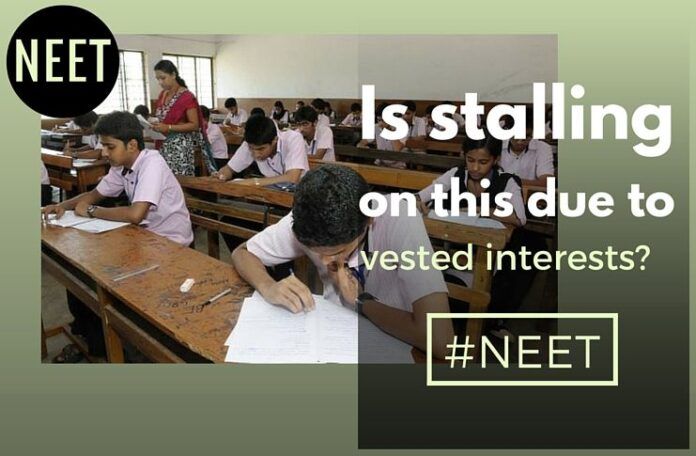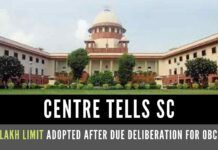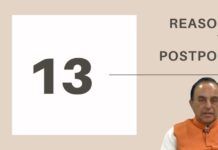
[dropcap color=”#008040″ boxed=”yes” boxed_radius=”8px” class=”” id=””]N[/dropcap]ational Eligibility-cum-Entrance Test (NEET) is the first landmark attempt; thanks to a Supreme Court judgement, to start a nationalised entrance examination for aspirants to medical colleges in India. The question obviously then, is why is NEET so controversial? And why have the central governments passed ordinances to postpone it by a year?
India has the highest number of medical colleges of any place in the world. As of 2015, India has 381 medical colleges, which admit about 64,000 students every year for undergraduate (MBBS) & postgraduate courses (MD/MS). Of these, 188 medical colleges are private colleges catering to around 40,000 medical seats. There are about 100 different entrance exams conducted by these various institutions, all having a different syllabus and exam patterns. Initially, they were only a few private institutions located mostly in the states of Tamil Nadu and Karnataka, who charged a substantial amount of money as capitation fees, making it an option only for the wealthy elite. This business practice under the guise of “providing education” was soon discovered by corrupt operators to be an extremely profitable venture with little risk and absolutely no responsibility. Multiple private medical colleges thus cropped up all over the country with the intent for quick profits, throwing basic standards of medical education to the wind. Despite the fact that many of them do not maintain appropriate standards as prescribed by the Medical Council of India, they continue to give medical degrees. Many of these corrupt institutions have developed political clout by aligning themselves with political parties or even been elected themselves by misuse of their financial power. Thus, these “Education Mafias” remain protected, and this menace ruins the entire medical education system in the country.
Most private colleges have their own entrance exams for ostensible reasons. There is little transparency to these admission procedures, and the system is exploited to garner maximum income by illegally selling medical college seats to the highest bidder. Any effort to induce transparency to this would obviously hurt this downright fraudulent activity. The merit of the candidate is not the dominant criteria, but rather an ability to dole out lakhs of rupees. This should not be interpreted as an indictment of all private players as depraved cutthroats. Many private colleges do exist that have maintained the highest standards and integrity as premier centers for providing medical education. CMC Vellore is one of them. The scenario with other private medical colleges, which are poster boys of corruption is different. Their very existence is based on questionable business principles. It might be remembered that NEET would have already been in place in 2013 if the Supreme Court had not turned it back based on a petition by mostly private medical colleges whose interests would be harmed by such a transparent exam. However, credit goes to the judiciary and the far-sighted judges. Despite opposition by strong financially vested interests, it has ordered a nationally viable transparent medical entrance exam for the country.
[dropcap color=”#008040″ boxed=”yes” boxed_radius=”8px” class=”” id=””]H[/dropcap]owever, starting NEET immediately has some practical problems, more for the examinees than the examiners. It may be recounted that following the announcement from the Medical Council of India that it would introduce the NEET exam in 2012, several states including Andhra Pradesh, Karnataka, Gujarat, West Bengal and Tamil Nadu strongly opposed the change. The reason they indicated was that there was a huge variation in the syllabus proposed by the MCI and their existing state curricula. This contention of multiple state governments has merit and needs more thorough investigation. It is impossible to expect thousands of examinees to prepare themselves for this examination with an extraneous syllabus by July 2016 when the second part of the exam is scheduled. This lack of a common playing ground would adversely affect many competitors required to compete with candidates used to the current syllabus. Thus, it would be unfair to those thousands of kids who need to orient themselves to this new syllabus in order to have a fair chance in the upcoming exam. Thus, delaying NEET for a year is a positive step to this end. The argument in some sectors that it will also help private operators to continue their raking in of loot is equally bona fide and not an exaggeration. However, it must be understood that when accosted by two evils, it is a lesser evil than having to deprive thousands of young people a level playing ground to sit for medical entrance. Administration of the NEET examination within a month or two as scheduled would be potentially disastrous to thousands of competing young minds looking for a bright future. Thus, ample time needs to be provided to create a uniform competing platform before any such test is implemented.
The present ordinance to postpone the application of NEET is a well thought out strategy by the present government but unfortunately restricts it to only state government seats. It should be extended to all candidates to enable them to get acquainted with the syllabus. The fact that it will be misused by the “Education Mafia” as has been for decades is hardly questionable.
- ModiCare – not enough to modify years of neglect! - April 23, 2018
- Gorakhpur Death-A Clarion Call to Change the Rotting Health System - September 22, 2017
- Paradise lost to violent radicals – Basirhat: a case in point - July 11, 2017











Do you have any idea or first hand experience how the admission process is in so called “great” pvt medical colleges whom you are eulogizing?
Hi, One more point is about PG there is no decision about PG-NEET yet so government should move fast on this things. If we take example like in PG 50% seat will goes for all India and 50% goes to University quota so that in 50% only university candidate is eligible. This scenario also need to be change. form single state i.e. student form Gujarat can able to take admission in any of university of Gujarat in other 50% quota(other then all India 50% quota) i.e. there should be rule like 50% quota for All India and 50% for state student it should not be university dependent. If possible please highlight it.
One factual error. The present Ordinance excludes Admission to Pvt Medical Colleges by their own exam, even in 2016. So AIPMT ( or NEET -1, conducted on 01 May 2016) and NEET-2 ( to be held on 24 July 2016) will still be the only mode of entrance for Pvt Medical Colleges from 2016 itself. This is a fantastic provision in the Ordinance and stops any malafide intent. Moreover all State Boards are free to conduct their own tests for this year only or accept NEET 1 and 2; eg Delhi Govt will not hold any State Medical tests inspite of this Ordinance and will consider NEET from 2016 itself, whereas West Bengal will have their WBJEE (Med) 2016 on 24th July 2016 itself. However a plea to stop this Ordinance is accepted in SC and so the last word is not spoken yet. Warm regards Subhabrata
I have thus asked the NEET to be postponed for all candidates. I supported the govt ordinance but did not say it was adequate. Students should have time to get on board with the syllabus before being forced to take any exam. This would also indirectly help the “mafia” absolutely but we have no choice.
The author is very misleading, deliberately I would say.
First he is adding medical undergrad and PG seats to come up with a total of 64,000 seats. Most sources say there are round 44,000/ undergrad seats and 22,000 PG seats in India. It might seem a lot for this author but US has 300 million people and 20, 000 medical seats per year, and India has 1.3 billion people. So proportionally there is one medical seat for 15,000 people in US and one medical undergrad seat for 30,000 people in India. India has 50% less seats in UG. When it comes to PG courses the acute scarcity is far worse. US has 27,000 seats available for residency program for each year. Doctors graduating from this come out with a MD in either Internal medicine, Pediatrics or their equivalent.
So, every year US graduates 27,000 MDs and India 22,000. Proportionally US graduated 1 MD for 11,000 people and India graduates 1 MD 60,000/ people. This is THE PROBLEM.
NEET will not do anything to solve the above problem or the problem of capitation fee. Good Medical schools like Manipal are not allowed to expand so, they have program with Malaysian and Nepalese govt, where they set up a colleges in Malaysia and NEpal. And our Medical grads go to China, Ukraine and Uzbekistan to study !
The central government for the first time actually listened to states and agreed to conduct this exam in other regional languages, presently it is conducted in only two regional languages Hindi/English ! They should make that de facto standard for all government exams…
Also, the National Education Policy should be amended to make the NCERT prescriptions mandatory and a minimum requirement in Science/Math/Geography/Economics/Commerce, if not done already. We should leave languages, history and other subjects to the state domains. Then 99% of the concerns of People of India would be addressed. For politics and states, you should allow states to follow their policy of admissions when there is no entrance exam, where there is one it should stand abolished and substituted by NEET.
That would be a 100% winning strategy. The ordinance by the government is a good compromise on this road. Here is sincerely hoping that our SealedCover Court will give up its ego and accede to it….